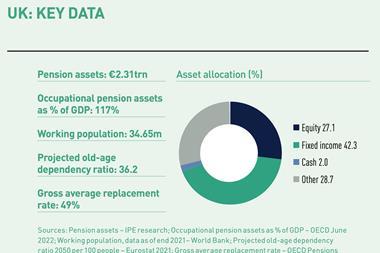Recent analysis of FTSE 350 defined benefit (DB) pension scheme funding conducted by consultancy Mercer shows a £35bn (Є39.6bn) surplus at the end of December 2022. This was a £111bn improvement in funding levels during the 12 months to December 2022, and a stark contrast to the £76bn deficit at the end of December 2021.
Mercer’s Pensions Risk Survey data analysis for December 2022 shows there was a small increase in surplus, driven by rising bond yields, from £31bn at end November 2022 to £35bn at end December 2022.
Rising bond yields could represent a “new normal” for 2023 with schemes potentially increasing their focus on locking in funding gains, whilst balancing liquidity and cashflow demands, according to Mercer.
The survey also showed that the present value of liabilities fell from £627bn at 30 November 2022 to £595bn at the end of December 2022, driven by a rise in corporate bond yields, offset to some extent by rising future implied inflation expectations.
Asset values also fell over the period to £630bn compared with £658bn at the end of November 2022, which reduced the impact of the liability falls, it added.
Matt Smith, principal at Mercer, said: “Our analysis shows that the aggregate funding position of FTSE 350 pension schemes, on an accounting basis, ended the year with a surplus, which is in stark contrast to the position at the end of December 2021.
“Some may ask whether this is the new normal. Many pension schemes have stayed resilient despite a year fraught with challenges and market volatility caused by the situation in Ukraine, the continuing impact of COVID-19 and Brexit, and market turbulence caused by the UK’s ‘mini-budget’. Now, schemes may find themselves closer to their end game and may be looking to capitalise on the improvement through 2023.”
In late 2022, The Pensions Regulator (TPR) launched two consultations on the regulatory aspects of the new DB pensions funding regime, building on the earlier consultations from both TPR and the Department of Works and Pensions (DWP), setting out more detail on TPR’s expectations for scheme funding.
The key requirement is for pension schemes to have an agreed long-term objective and journey plan.
Smith added: “The TPR consultation is timely. Trustees and employers are taking stock of what’s next: securing their end game and assessing newer options such as consolidators or pursuing run-off. We expect journey plans will now also be taking account of recent investment changes.”
The said that 2022 “demonstrated the value in robust planning and collaboration, which will be key aspects for trustees and employers in looking forward and agreeing realistic objectives”.
Mercer’s Pensions Risk Survey data relates to about 50% of all UK pension scheme liabilities, with analysis focused on pension deficits calculated using the approach companies have to adopt for their corporate accounts. The data underlying the survey is refreshed as companies report their year-end accounts.
To read the digital edition of IPE’s latest magazine click here















